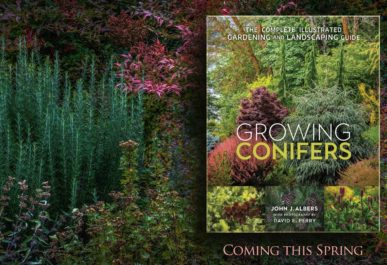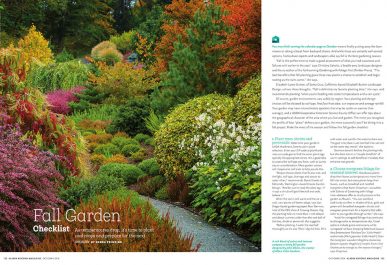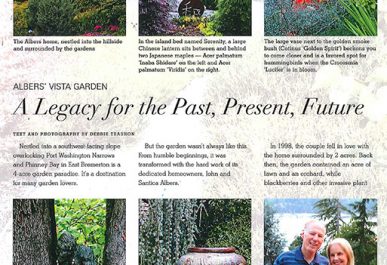Washington Park Arboretum Bulletin (Fall 2013)
November 10, 2013Green uprising: Hillside garden of two physicians is an oasis of botanical diversity
May 14, 2014
Article by Valerie Easton published Sunday, February 2, 2014 on the Seattle Times’ magazine.
Invalid Displayed Gallery
John Albers is a research scientist, University of Washington professor of medicine and passionate environmentalist. For years he squeezed horticulture classes into his busy schedule and gardened wherever he lived. Then in 1998, he and his wife, Santica Marcovina, bought a hilltop home near Bremerton. They started with two acres of native woodland and lawn, then bought a weed-infested horse pasture for a total of four acres now in cultivation.
Albers grew up raising vegetables in Illinois, but he’s taken to gardening here as if born to mountains, seascapes and glacial till. Undeterred by Himalayan blackberries, morning glory and Scotch broom, Albers set in to make a garden showcasing plants that adapt to Northwest conditions as readily as he has. And what rich cultivation it is, with thousands of plants from around the globe growing harmoniously together on this Northwest hillside. “I favor plants that look compatible, as if they should be living here. I wouldn’t plant a monkey tree,” he says.
Albers dug out invasives by hand, creating a pile of ivy that towered 15 feet high by the time he finished. He adds compost and mulch to improve the clay soil, planting ribbons of lavender through the sandy areas of the garden. Albers constantly culls plants that don’t measure up. “Ceanothus is off my list, it’s too short-lived,” he declares.
How can one person, even with part-time help, maintain such a huge garden? “I don’t think globally . . . you’d go nuts. I work one area at a time.” In the woodlands, he edits out invasive plants and lets natives fill in. Is he daunted by the garden’s steep topography? “Never,” says Albers. “I get my exercise out here.” The newest garden of roses, planted for his wife, is way up top. A pergola offers a widescreen scene of a garden tapestry so complex and textural that it competes with the view of Mount Rainier.
“I’m a collector, obviously,” Albers admits. About a quarter of all the plants at Vista Gardens are natives, from robust madrona trees to patches of ankle-high, Pacific Coast iris. Whether he’s working with natives or ornamentals, Albers adheres to his goal of sustainability by planting a garden that consumes as few resources as possible.
Once plants are established, Albers expects them to stay healthy with a minimum of pruning, watering, fertilizing and deadheading. From swathes of ground-hugging conifers and helianthus to meadows of wildflowers, the plants seem to live up to his expectations. And how about self-seeders? “Forming a partnership with nature is part of sustainability,” says Albers, who lets most volunteer plants stay wherever they happen to pop up.
Conifers are a specialty; he grows 150 kinds. He’s turned an old driveway into a Japanese-style garden with islands of dwarf conifers softened by sedums. The bio-filtration garden, over the septic system, is an open, sunny meadow planted in grasses, native flowers, rosemary and lavender; no supplemental water needed.
The four acres are divided into garden rooms, with a pollinator pathway, a rain garden and a stroll gallery featuring bamboo and various grasses. When a friend gifted Albers a number of unique rhododendron hybrids, he planted a canopy of Japanese and stripe bark maples to shade his new collection. All the gardens are woven together with pathways made of stone hand-picked and laid by Albers. Planted for seasonality, the garden ebbs and flows around the permanence of stone and artwork placed to distinguish the various rooms.
This ambitious gardener is working on what he considers his most important projects yet. He’s writing a book on preserving biodiversity in urban environments. Close to his heart are his hopes to preserve his own masterpiece of a garden in perpetuity. “I’ve planted all these oak trees for future generations to enjoy,” says Albers.
Valerie Easton is a Seattle freelance writer.



